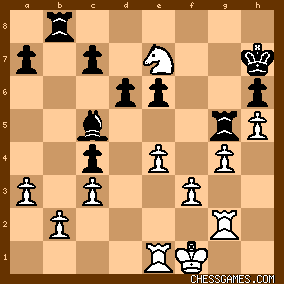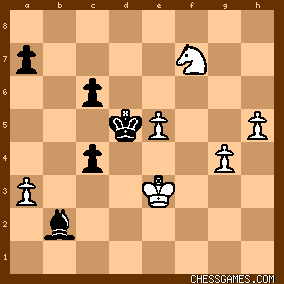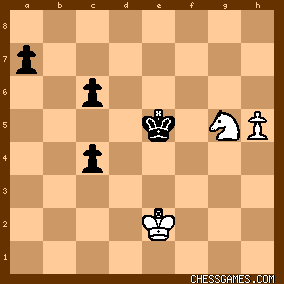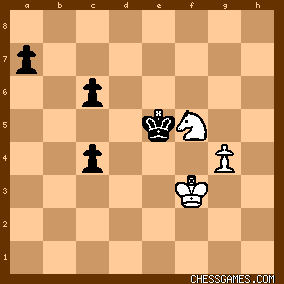| Aug-22-13 | | Caissanist: Edward Lasker doesn't give the score of this game in his book <Chess Secrets>, but tells quite a story about the circumstances surrounding it. According to Lasker, he struggled throughout the early stages of the game, losing a pawn but was eventually working up counterplay. The game was finally adjourned in "an unclear position in which anything could happen"; he felt confident of a draw, which would have left him in contention for third prize. He therefore went out partying all night with Alekhine, not leaving the nightclub until after seven in the morning. When he sat down to play his adjourned game at nine, he of course ruined it, forcing him to settle for fifth prize, bitterly disappointed. "I swore I would never drink and look at the girls again during a tournament." Like many of the anecdotes in that book it's a great story, but doesn't seem to stand up when you do some digging. Black is simply busted in the position after move 30, or anytime later. He's a pawn down, has <four> isolated pawns, is weak on the light squares, and is stuck with a bad bishop that can do little more than defend one of the pawns. I do like te Kolste's winning technique--first attack the isolani with the queen, thereby forcing black to accept a queen trade. Then alternate threats to create passed pawns by pushing them, and use the knight to attack black's pawns. Eventually his opponent's position becomes cramped, and te Kolste wins another pawn through the kind of tactics that normally flow from this kind of position. Still, it's not something you wouldn't expect a decent master to be capable of. Maybe Lasker could have prolonged the game with more rest, but I don't see how he could have saved it. |
|
| Aug-22-13 | | JimNorCal: Which move is the adjournment?
You could be right, but looks like Lasker goes down a pawn at move 21, with a bad position.Then, by move 45, the black pieces are about as active they will get in this game. He has a bishop versus a knight. The bishop controls key squares that make it awkward to double white rooks on the kingside. The white rooks are forced to defend b2. If te Kolste dithers, then maybe black could get back in the game. But he doesn't. Black is at his high water mark and the position decays. By about move 50, the situation is reversed. The kingside has open lines, the black rooks are tied to d6 and have lost their mobility. I don't disagree with your analysis, just saying that Lasker might have had a rational basis for hoping that te Kolste would falter. Perhaps Lasker was thinking "dang, this guy has been making mistakes all week--how come he can't blunder in THIS game?" |
|
| Sep-09-13 | | Caissanist: Lasker doesn't say at which move the game was adjourned. The first time control was 30 moves in 2 hours, but if they were playing fast they could of course have adjourned several moves later. I guess it's possible that they adjourned around move 45. As you say, Lasker's drawing possibilities were dependent on whether te Kolste "dithered", and he didn't. |
|
| Jul-17-19 | | sneaky pete: The tournament book, edited by S.W. Weisfelt, secretary of the Dutch Chess Federation, was epublished in 1914. It contains some notes by Lasker on this game. These annotations are probably based on a conversation between Lasker and Weisfelt immediately after the game. So no time for critical reflection and research, just off the cuff comments. My impression is that Lasker didn't realise how bad his position was after his first mistake (move 17). He suggests for instance that after 43.Kf1 .. 
click for larger viewhe avoided a draw by repetition with 43... Rf8 44.Ke2 .. because he played for a win! I think that in this line after 44.Rg3 .. white maintains an advantage. A critical position arises after after 60.Ke3 .. 
click for larger viewLasker blames 60... Ke6 for his loss and claims that 60... Bxa3 would have secured a draw. It is true that after 60... Bxa3 61.g5? Bc1+ 62.Ke2 Bxg5 63.Nxg5 Kxe5 
click for larger viewthe game is drawn, but after 60... Bxa3 61.h6! Bc1+ 62.Kf3! Bxh6 63.Nxh6 Kxe5 64.Nf5 .. 
click for larger viewblack is lost.
*******
Unfortunately there are no details about either time control schedules or
position(s) at adjournment.
*******
Lasker also claimed, without giving any evidence, that 60... Bc1+ followed by ... Ke6 would still have given him (and not Te kolsté!) winning chances, but maybe he was still drunk after his night out with that other tippler. |
|
| Feb-09-24 | | spektrowski: Time control in Scheveningen was quite exotic: 34 moves in 2 hours, then 17 moves per hour. |
|
|
|
|





